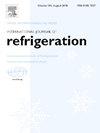Sensor fault detection, diagnosis, and data reconstruction strategy for chiller based on an improved tree-based pipeline optimization tool framework
IF 3.5
2区 工程技术
Q1 ENGINEERING, MECHANICAL
International Journal of Refrigeration-revue Internationale Du Froid
Pub Date : 2025-02-12
DOI:10.1016/j.ijrefrig.2025.02.013
引用次数: 0
Abstract
Machine learning is widely applied to fault detection, diagnosis, and data reconstruction for chiller sensors but often requires domain expertise and manual intervention. Tree-based Pipeline Optimization Tool (TPOT), an automated machine learning framework, shows promise in fault detection, diagnosis, and reconstruction by automating model optimization and parameter tuning. Although the TPOT framework includes automated data preprocessing functions, it lacks the ability to automatically handle outliers. Outliers in sensor data can adversely affect the quality of the modeling process. By leveraging TPOT's capability for automated modeling, an ensemble fault diagnosis model can be developed. However, this model is prone to misdiagnosis when the sensor variables exhibit high correlations. Therefore, this study proposes an improved TPOT framework by incorporating a sliding window strategy to enhance TPOT's ability to handle outliers. The ensemble fault diagnosis model based on TPOT incorporates a Euclidean distance strategy, which identifies faulty sensors by quantifying the difference between the input data and the predicted results. Results show that the improved TPOT framework enhances fault detection, diagnosis, and data reconstruction. In the detection of sensor bias, drift, and precision degradation faults, the fault detection rates increased by a mean of 3.11 %, 4.64 %, and 8.62 %, respectively. The diagnostic strategy incorporating Euclidean distance reduced the number of misdiagnoses by one in the diagnosis of nine different sensor faults. In sensor data reconstruction, the RMSE was reduced by a mean of 68.26 %.
求助全文
约1分钟内获得全文
求助全文
来源期刊
CiteScore
7.30
自引率
12.80%
发文量
363
审稿时长
3.7 months
期刊介绍:
The International Journal of Refrigeration is published for the International Institute of Refrigeration (IIR) by Elsevier. It is essential reading for all those wishing to keep abreast of research and industrial news in refrigeration, air conditioning and associated fields. This is particularly important in these times of rapid introduction of alternative refrigerants and the emergence of new technology. The journal has published special issues on alternative refrigerants and novel topics in the field of boiling, condensation, heat pumps, food refrigeration, carbon dioxide, ammonia, hydrocarbons, magnetic refrigeration at room temperature, sorptive cooling, phase change materials and slurries, ejector technology, compressors, and solar cooling.
As well as original research papers the International Journal of Refrigeration also includes review articles, papers presented at IIR conferences, short reports and letters describing preliminary results and experimental details, and letters to the Editor on recent areas of discussion and controversy. Other features include forthcoming events, conference reports and book reviews.
Papers are published in either English or French with the IIR news section in both languages.

 求助内容:
求助内容: 应助结果提醒方式:
应助结果提醒方式:


